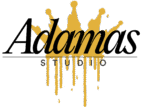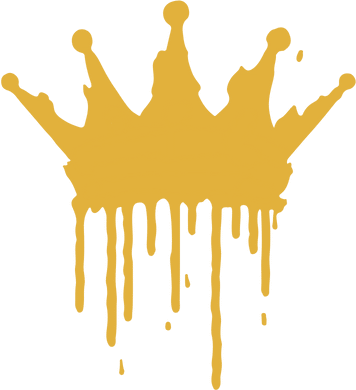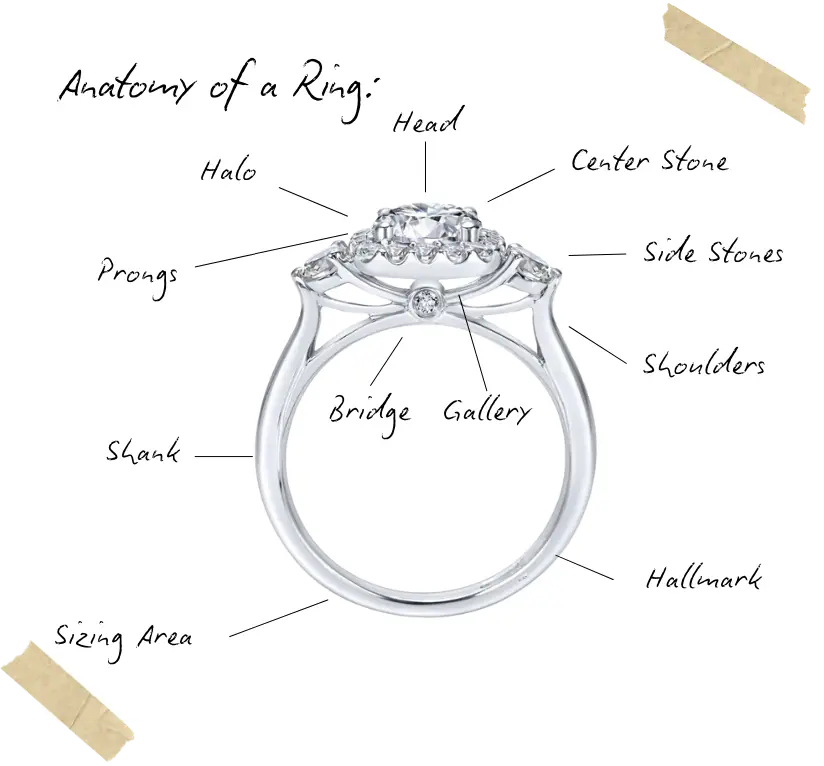
When it comes to diamond rings, every detail plays a part – and some very important ones.
From the prongs that secure your stone to the shoulders that guide the eye, understanding the anatomy of a ring helps you make confident, informed design decisions.
The Head #
The head is the topmost section of the ring that holds the centre stone in place. This part of the ring works hard to keep your diamond secure and perfectly positioned for maximum brilliance.
The prongs are the small metal arms that grip the stone, which can be rounded, claw-shaped, or flat, and the number of prongs (usually four or six – it should never be less!) impacts both security and visibility of your stone, letting light through so the diamond sparkles.
The basket is the structure beneath the stone that connects the prongs. Think of it as the stone’s foundation that supports the diamond and enhances its stability.
The peg connects the basket to the ring shank, and should have as much surface connection to the ring as possible: keeping the head safe and secure.
The Centre Stone #
The showstopper of the ring, the centre stone, is what everyone notices first. Whether it’s a diamond or a gemstone, its cut, shape, and size dictate the overall design.
The Halo #
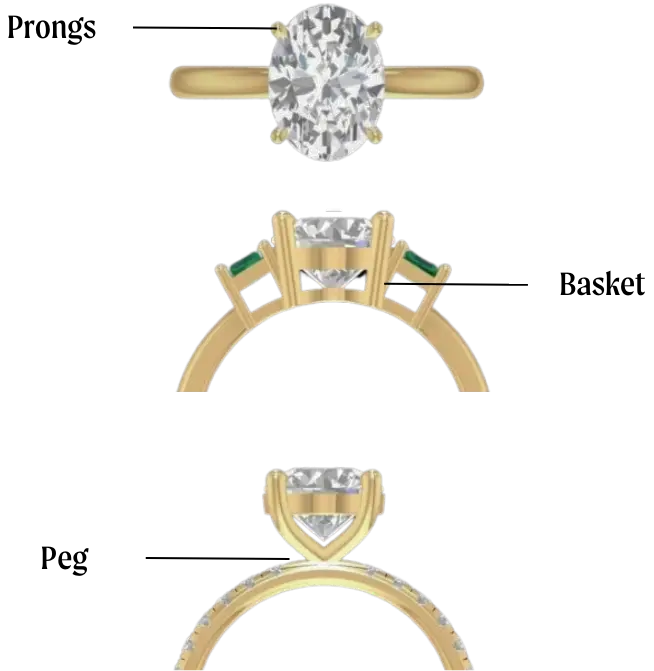
If the centre stone is the star, the halo is its spotlight. If you choose to have one, a halo features a circle (or other shapes) of smaller diamonds or gemstones surrounding the centre stone: it adds extra sparkle and creates the illusion of a larger centre stone.
The Shoulders #
The shoulders are the sides of the ring that lead up to the centre stone. They frame the diamond, guiding the eye to the centre stone, and add structural, personalisation, and stylistic elements. Styles for ring shoulders might include plain, pavé, engraved, milgrain, tapered, or split
The Gallery #
The gallery is the area just beneath the centre stone, often visible when the ring is viewed from the side. This can add a welcome subtle decorative element while also providing additional support for the stone.
The Shank (Band) #
The shank, or the band, is the circular part of the ring that wraps around your finger. It’s not just a design element – it’s also the ring’s foundation.
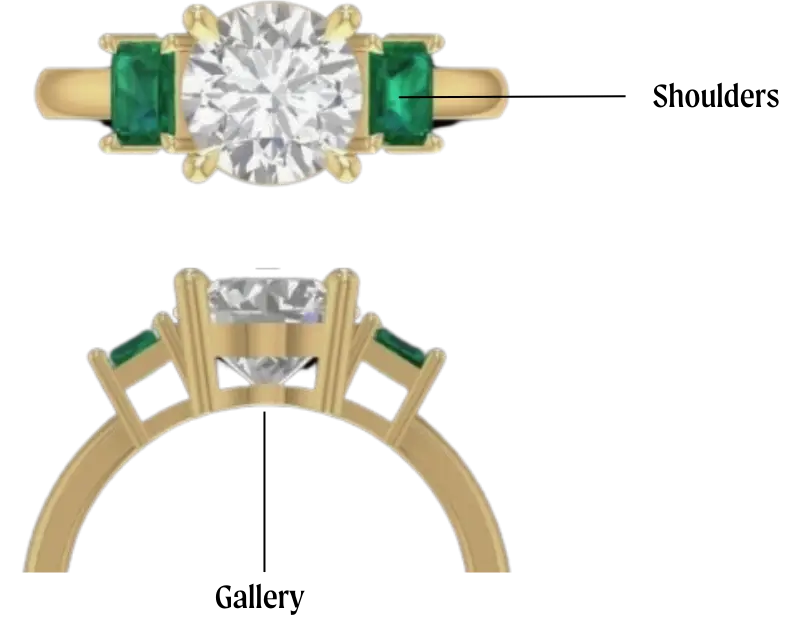
Wider bands are more durable and suit larger stones, while thinner bands create a petite and delicate look. We recommend not straying below 1.8mm for a band that remains sturdy and durable.
The depth of the band – its thickness – is just as important for structural integrity. We like to keep to at least 1.6mm to ensure our rings are strong enough for daily wear.
Shanks can be straight, curved, tapered, split shank, or even reverse tapered.
The Sizing Area #
The sizing area is the bottom portion of the band (also called the base or underside). This part of the ring can be adjusted for resizing.
What it does: Ensures the ring fits comfortably while maintaining its structure.
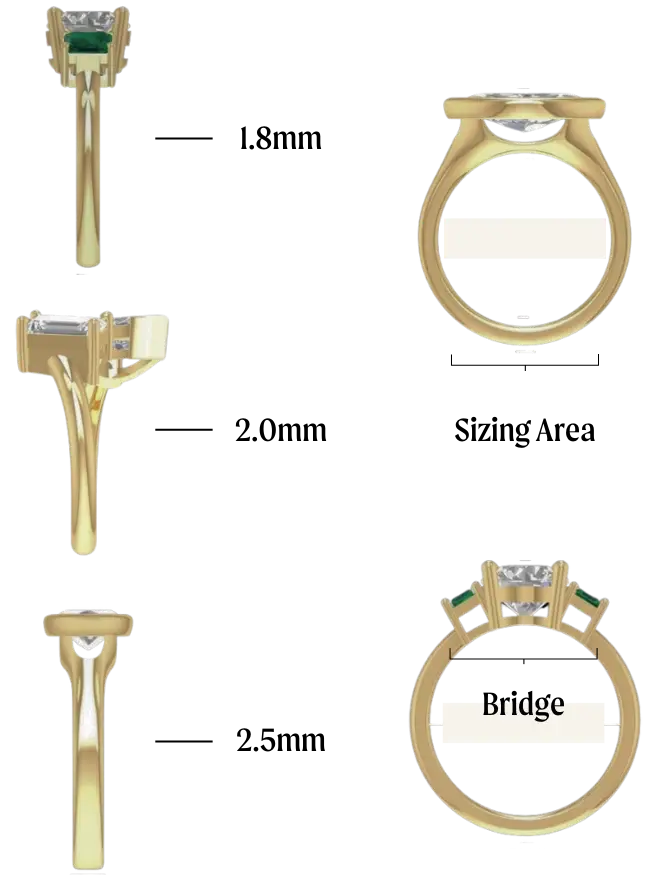
Pro tip: Eternity bands (with stones all around) cannot easily be resized, so choose sizing carefully.
The Bridge #
The bridge is the inner curve of the ring between the shoulders and the sizing area. While often overlooked, it can feature hidden details like engravings or accent stones.
Accent Stones #
The accent stones are smaller diamonds or gemstones that are often set along the shoulders, gallery, or bridge. They add sparkle and detail, complimenting the centre stone. Settings like channel or bezel are often the best choice for extra durability.
The Hallmarks #
The hallmarks are small stamps on the inside of the band that indicate metal purity (e.g., 18k gold, platinum).
In the UK it’s a legal requirement for all gold items above 1g in weight (and 0.5g in platinum) to be tested and hallmarked, and we get ours certified at the Goldsmith’s Company Assay Office in London. Legally, all gold items above 1g in weight (and 0.5g in platinum) must be tested and hallmarked, certifying your metal’s purity. The hallmark is a stamp that includes confirmation of the metal, where it was marked, when it was marked, and the item’s sponsor (who made it – that’s us!).
Understanding the anatomy of a diamond ring helps you design a piece that’s not only beautiful but also practical and durable. At Adamas we make sure every detail – from the prongs to the gallery rail—is thoughtfully considered, so your ring is a perfect match to you and your story.
